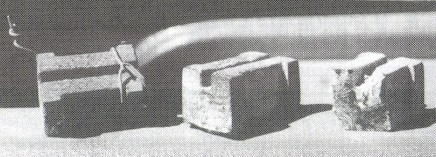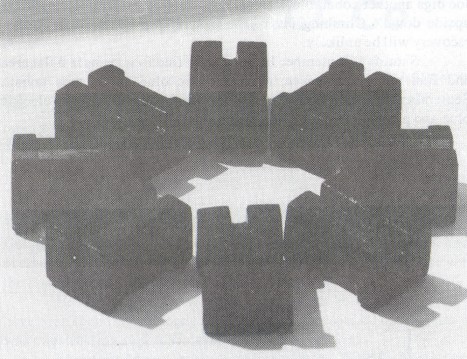Chips Off The Old Sierras' Blocks
by Ron Souza
Reprinted from "Crown Jewels of the Wire", November 1994, page 4
For nearly 15 years, I have been involved with research on a high Sierra
telegraph system that had serviced some of the early gold mining communities
during the 1850's...
In 1981, while making an exploratory trip in the area, I had found a side
bracket in a cedar tree. This bracket had an angular hole drilled into it to
accept an unusually small support pin for an insulator. Digging the span netted
nothing in the way of evidence of line construction methods. Because research
mapping of other early telegraph lines were taking priority, it was necessary to
remove the bracket and put this line on the back burner for a while.
In late
July, 1994, we had planned a trip back to the area to renew research on the
line. Unfortunately, my business required that I work that Friday. It is rather
brutal when you are reminded that first you are "bread winner" and
then you can be "telegraph man." My son, Joe, and cousin, Don
Albrecht, undertook the unpleasant duty of going into the mountains in my
absence.
There are two types of phone calls I don't like to receive at work. One
is a family emergency and the other is, "Hey, Dad, what are you
doing?" Followed by, "Get your camera and ladder and come up
here."
That afternoon, about 3 p.m., I was looking up at an extremely tiny
rubber hat insulator on its side bracket, still hanging in the tree. After
completing the photo session we set up the ladder for closer inspection. I was
looking at a small Goodyear patent rubber hat bonded to a metal shank and
installed in a small wooden bracket.

After we removed the insulator, we metal detected the area and found some
wire heading out from this span. We decided to hang it up for a while and call
in our other hunting partner, Jim Sanders. Hearing of the find and knowing the
regional show was to be in Auburn, California the following weekend, Jim thought
he would come up and maybe we could go out that Sunday. The hat caused quite a
stir at the Auburn show. (It was part of the Western Telegraph Research Association's display case
along with other artifacts from early telegraph
lines.) By the time the show had ended, Jim was in a hurry to go to the
mountains.
Sunday morning we were on the mountain by 8:00 a.m. and by early
afternoon it was obvious that although we had found wire and other evidence,
there would be no threadless this time. Secretly believing in a conspiracy but
having the dignity to keep it to himself, Jim boarded his plane home to face
another work week and his wife's subtle question ---- "How did you do,
dear?"
Joe and I had a conference and decided to investigate other areas of
the line in the following weeks. Wanting to inspect another northern California
system and to give my wife Pat an outing that she should have had weeks earlier,
we left for Red Bluff, California on Friday, August 12th. About 8:30 a.m.
Sunday, the cellular phone in the van rang and I was again subjected to
"Hey, Dad, what are you doing?" Gosh, I hate that!
Sure enough, it was
followed by, "I found the lower section of the line and it has glass blocks
on it!" Doing my best to be clinical, I asked, "Were there any
intact?" The answer was that there were two complete specimens and one
broken.
After telling Joe that we would be home about 1:00 p.m. and just before I
hung up the phone, Joe said, "Oh, Dad, these things are cobalt blue!"
Boy, can this kid push my buttons! Upon arriving home, Joe was just coming up
the street.
Walking into the house, Joe held a cobalt glass block in his hand
that was absolutely purple cobalt!. He extended his hand and said, "Here,
Dad, this is yours." Talk about raising your children properly!
After
discussing the alignment and events of the week, we decided to call Jim Sanders
and let Mike Guthrie in on the news. The following weekend Jim arrived at the
house and our crew of Joe, Don, Jim and myself headed back to the mountain.
The
first span we dug was located by Joe on his previous trip. He and Jim proceeded
to carefully dig the span. When you touch glass with a rake, it emits a high
pitch clinking sound. Well, deaf as I may be, I turned around and observed Jim and my son exchanging high fives. Resting in
the middle of their dig pattern was half of a cobalt block. Checking to see if
Jim had lost control of all bodily functions (and admiring him for not doing
so), I got out the camera for a photo session. (It is extremely important to
record every find for future historical reference.)
An hour of digging of this
span did not net the other half of the block and we decided to move to the next
span. After locating it, we lined up four wide and proceeded to dig the area in
orderly fashion. Jim yelled, "I found another one!" I might add at
this time that this is no way for a guest on a dig to act. This block was also
broken in half, and the remaining piece unobtainable. I found what may be
another span later in the day and we started to dig. Within a minute, I had dug
a beautiful specimen. Even covered with dirt these things are beautiful!
When
you dig up one of these things, there are two emotions. The first is joy, the
second is melancholy of knowing one less insulator is out there to find. After
photos were taken, I wanted to console my friend Jim after he dug two broken
units, so I said to him, "That is the way it is done, bucko!"
Heck,
politics has never been my game. Staring eye to eye with my somewhat peeved
friend, Jim, and wondering what emotional scars I had put on his soul, we heard
Joe ask for a camera because he had found a block with wire still on it. This
one was light blue. This put the finish to a really outstanding day and we
headed home.
Friday, August 26th was Joe's birthday and to celebrate he took the
day off to try and find alignment again. Coming into the house for birthday
dinner, he showed his mother and I another block, the result of one whole day's
digging. With Labor Day approaching, the group made another plan to dig on the
line. September 1st found us approximately two miles from our first dig site.
It had taken Joe about 4-1/2 hours August 26th to find the alignment. Jim found
the first block. It was a beautiful teal/aqua color in perfect condition. Joe
then dug another out of the same glass batch but with chunks of green moss
colored glass in it. We came to the edge of the mountain and could no longer
find alignment. Water mining had washed it away.
Late afternoon found us back
near the original dig site. There was not a lot of hope because of surface
fires, but with a line like this you check every foot. After chastising the
troops for working too fast, Joe calmed back down and we returned to our
regimented procedure.
Don was digging a span and had the hill pretty much
destroyed, including the removal of an extremely large manzanita bush. About three
inches below the root system was the nicest cobalt block yet! The fire had done
no damage.
Evidences of another span was uncovered about dark and I started to
dig. Eight inches from the edge of this dig was another mint cobalt block. It's
funny that when you dig a cobalt insulator, it first appears black or amber and
then blue. I have seen this with E.C.&M.s and Cal. Elec. units and now with
these blocks.
The hike back to camp saw us with two aqua and two cobalt blocks.
It doesn't get much better than this! Friday morning, September 2nd, we head off
the flat into the canyon. After looking into the abyss, I have a feeling that
finding a complete insulator down there would be impossible.

About one hour into
the hike, we felt we had a span. Sticking out of the ground was the comer of
.another block. This is a nice unit, and Jim now has a cobalt. Note: If you want
to keep this hobby enjoyable, always share equally with your hunting companions.
In the long run it will balance out and you will remain friends for a long time.
Later in the afternoon, Don and I dig the iron pin for a hat and Joe digs another cobalt block. This one is on the side of the mountain,
upside down. Climbing out of the canyon, we believe that further recovery will
be unlikely. Saturday, September 10th Joe and I find four spans in a flat area
and find an opaque green, aqua, electric blue and a nice cobalt. September 19th,
Lou Dieke (a California bottle digger) dug an electric blue and a cobalt about
3/8 of a mile from this dig. I thank Joe for his perseverance, my hunting
companions for the hours of good company and whatever power that provided this
good fortune.
| 